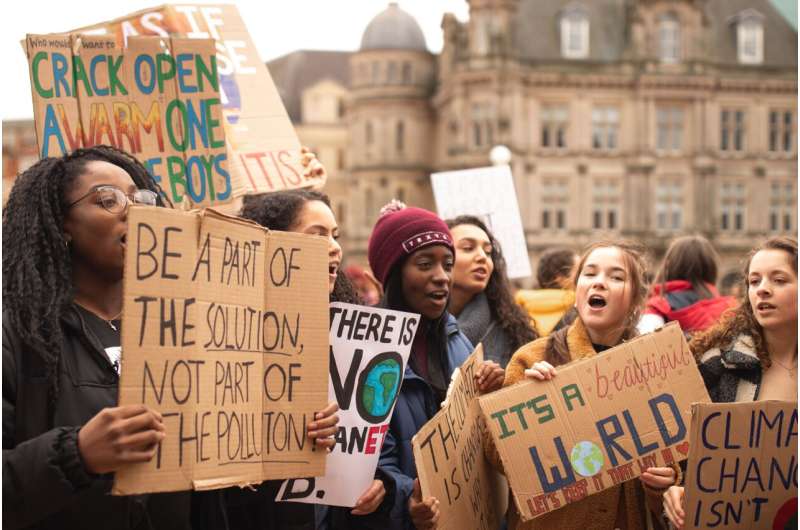Credit: Unsplash/CC0 Public Domain
Hundreds of thousands of school students around the world will strike for climate justice on Friday 25 March. These strikers, and new research, demonstrate that climate change requires our educational system to "radically reimagine" the core purposes and practices of education towards those that can cultivate a liveable planet and climate justice, said Dr. Blanche Verlie.
Dr. Verlie is a climate justice expert in the Sydney Environment Institute at the University of Sydney. She is the guest co-editor with Alicia Flynn, a Ph.D. candidate from the University of Melbourne, of a special issue of the Australian Journal of Environmental Education on research around the global school strikes.
"Students are striking because they are terrified of the future they are inheriting and horrified by the unequal implications for others," said Dr. Verlie.
"Young people are becoming climate change educators. They have been teaching themselves and others, from their peers, to parents, teachers, communities, politicians, and scholars. Students must navigate complex political terrain in order to fight for their futures. Given all of this, we need to reimagine education in these climate-changing times."
School strikes
The first school strike started when one 15-year-old Swedish girl, Greta Thunberg, sat alone outside the Swedish Parliament asking for a radical reduction in greenhouse gas emissions. That was 2018. Since then, Thunberg has rallied roughly 10 million people from 260 countries to join in the school strikes. In Australia, the movement is called School Strike 4 Climate.
While school strikes have reached a worldwide crescendo, Dr. Verlie and her co-editor Ms. Flynn, say that youth activism and school strikes have a long history.
For decades, youth activism and school strikes have been run by organizations such as the Australian Youth Climate Coalition, Australian Student Environment Network, Seed Indigenous Youth Climate Network (Australia) and the Pacific Climate Warriors (Pacific Islands). Young BIPOC (Black, Indigenous and People of Color) leaders such as Xiuhtezcatl Roske-Martinez, Jamie Margolin, Hilda Nakabuye have also had huge impact across the world with climate justice activism.
However, the Thunberg-led strikes have taken the climate action to a new level, according to Dr. Verlie.
"There is now a critical shift in youth climate activism as well as political action more broadly and, as this report explores, one that directly enrolls education and schools into the arena of climate politics," Dr. Verlie said.
"One oft-used school striker placard reads, 'we are skipping our lessons to give you one' and in this research collection, we argue that it is the duty of educators and education scholars to pay attention to what we might learn about climate education from school strikers."
More learning, more activism
In 2018, Prime Minister Scott Morrison said schools need "more learning and less activism." However, Dr. Verlie's research puts this into question—showing that schooling is not meeting children's needs for holistic, action-oriented climate change education.
"Instead, young people are learning a suite of skills through striking from school —leadership, communication, team building, and organizational, democratic and critical analysis skills—and are teaching others as they do so," Dr. Verlie said.
The research in the special issue of the Australian Journal of Environmental Education found five key themes:
- Students are striking because of the affective weight of climate injustice.
- Students learn through their participation in striking, in contrast to the often insufficient climate change education taught in schools.
- Young people are becoming climate change educators through their roles as strikers.
- Strikers are patronized through paternalistic structures (including schooling) that ostensibly exist to protect them.
- Therefore, we need to reimagine education.
Education needs to change
Many students in Australia have experienced the direct results of climate change with their schools closed due to bushfires or floods. "The students know the stakes are high," said Dr. Verlie. "The strikers say the activism is learning—therefore we believe that learning must be activism."
The researchers propose four radical changes to education:
- Recognize that young people are living through climate change right now and it's not something to be studied from a dispassionate distance.
- Take young voices seriously; educators must listen to, support and work alongside their students.
- Reconsider the outdated notion that students can be educated to "manage" the planet; instead embrace collective responsibility.
- Learn to respond to uncertainty and complex challenges.
The research
The special issue of the Australian Journal of Environmental Education is a collection of new research articles that explore the failures and opportunities of climate change education in light of the school strikes.
The research gathered is from a range of education, social movement, and youth studies academics across Australia and the world, including Associate Professor Amanda Tattersall, from Sydney Policy Lab at the University of Sydney, Associate Professor Greg Lowan-Trudeau from the University of Calgary, and Dr. Ben Bowman from Manchester Metropolitan University.
Two of the papers are co-authored with School Strike 4 Climate leaders from Australia: Varsha Yajman, Jean Hinchliffe, Harriet O'Shea Carre and Niamh O'Connor Smith.
Overall, the research demonstrates that students are learning how to seek justice out on the streets through the school strikes.
More information: Blanche Verlie et al, School strike for climate: A reckoning for education, Australian Journal of Environmental Education (2022). DOI: 10.1017/aee.2022.5
Provided by University of Sydney
























